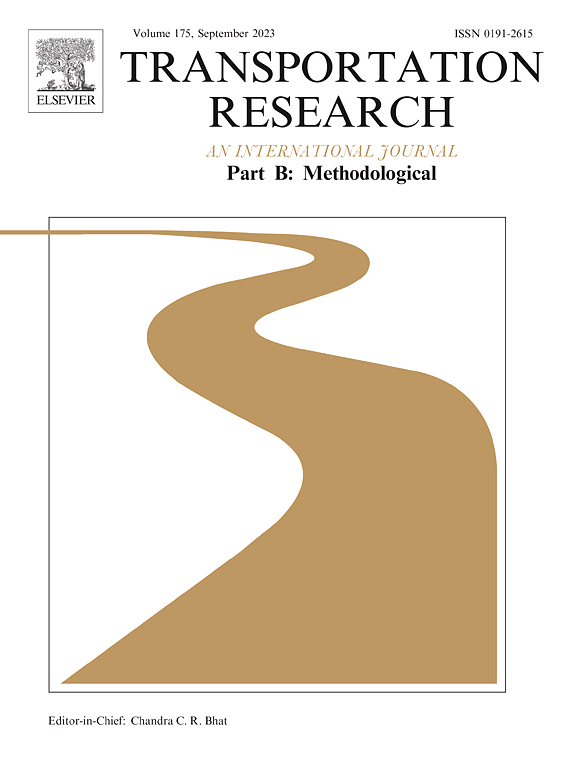具有内生用户均衡的道路定价博弈理论模型,包含多个用户等级
IF 6.3
1区 工程技术
Q1 ECONOMICS
引用次数: 0
摘要
本文提出了道路收费的博弈论模型。该模型结合了可变用户需求和多用户类别的内生需求和路径选择用户均衡。与大多数文献不同的是,所提出的模型允许以直接的方式计算最佳通行费,而不是通过外生通行费值的反复试验,并解决了非活动路径可能变得活跃的问题(反之亦然)。此外,在不同背景下拥有多个政府的游戏也可以得到解决。我们分四个阶段进行。首先,建立了用户均衡模型来预测一般用户对政府收费工具的反应。对多个用户类别进行建模,可以区分具有不同时间价值和旅行付费意愿的用户。此外,它允许不同的收费工具针对这些用户。其次,制定了一个单人优化问题,以找到作为Stackelberg领导者的政府对用户的最优收费值。第三,为了处理用户均衡路径流的非唯一性,提出了一种基于启发式的后处理方法,该方法有助于识别适当的访问限制,以避免次优用户响应。第四,将单一玩家优化问题作为构建块,开发一个通用博弈论框架,该框架可应用于不同类型政府之间的不同竞争场景,每个政府可能涉及网络或社会的不同部分。然后,将该模型应用于四个说明性案例研究。第一个案例研究涉及单人玩家优化问题,并以三种解决方法的比较结束。混合整数二次规划是最快的,也是最一致的。第二个案例研究涉及两个政府和两个用户类别的博弈论问题,并详细阐述了四个竞争场景。它证明了中心目标函数如何只会因玩家之间的任何竞争而恶化,并且玩家有动机将纳什博弈转化为Stackelberg博弈。第三个案例研究具体解决了用户平衡路径流的非唯一性,并在后处理中评估了两种不同级别的访问限制。最后,第四个案例研究展示了将单人优化问题应用于现实世界的城市交通问题。本文章由计算机程序翻译,如有差异,请以英文原文为准。
A game-theoretical model of road pricing with an endogenized user-equilibrium with multiple user classes
This paper presents a game-theoretical model of road pricing. The model incorporates an endogenized demand and path-choice user-equilibrium with variable user demand and multiple user classes. Different to most of the literature, the proposed model allows to compute in a direct way the optimal tolls, rather than by trial and error of exogenous toll values and tackles the problem of inactive paths that can become active (and vice-versa). Additionally, games with multiple government in different settings can be solved. We proceed in four stages. Firstly, the user-equilibrium model is developed to predict the response of general users to toll instruments of the government(s). Modelling of multiple user classes allows to differentiate users who have different Value of Time and Willingness-To-Pay for their trips. Further, it allows such users to be targeted by different toll instruments. Secondly, a single-player optimization problem is formulated to find optimal toll values for a government acting as a Stackelberg leader over the users. Thirdly, to handle the non-uniqueness of user-equilibrium path flows, a heuristic-based post-processing method is presented that helps in identifying suitable access restrictions necessary to avoid the suboptimal user responses. Fourthly, the single-player optimization problem is used as a building block to develop a general game-theoretical framework that can be applied to different competition scenarios between different types of governments with each, possibly, tolling a different part of the network or the society. The model is, then, applied to four illustrative case-studies. The first case-study involves a single-player optimization problem and ends with a comparison of three solution methods. Mixed Integer Quadratic Program is shown to be the fastest as well as the most consistent. The second case-study involves a game-theoretical problem with two governments and two user classes, and four competition scenarios are elaborated. It is demonstrated how the central objective function can only be worsened by any type of competition between players, and that players have an incentive to take leadership to convert a Nash game to a Stackelberg game. The third case study specifically addresses the non-uniqueness of user-equilibrium path flows, and two different levels of access restrictions are assessed in the post-processing. Finally, the fourth case study shows an application of the single-player optimization problem to a real-world urban mobility problem.
求助全文
通过发布文献求助,成功后即可免费获取论文全文。
去求助
来源期刊
CiteScore
12.40
自引率
8.80%
发文量
143
审稿时长
14.1 weeks
期刊介绍:
Transportation Research: Part B publishes papers on all methodological aspects of the subject, particularly those that require mathematical analysis. The general theme of the journal is the development and solution of problems that are adequately motivated to deal with important aspects of the design and/or analysis of transportation systems. Areas covered include: traffic flow; design and analysis of transportation networks; control and scheduling; optimization; queuing theory; logistics; supply chains; development and application of statistical, econometric and mathematical models to address transportation problems; cost models; pricing and/or investment; traveler or shipper behavior; cost-benefit methodologies.

 求助内容:
求助内容: 应助结果提醒方式:
应助结果提醒方式:


